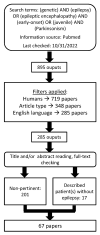Pediatric-Onset Epilepsy and Developmental Epileptic Encephalopathies Followed by Early-Onset Parkinsonism
- PMID: 36835207
- PMCID: PMC9965035
- DOI: 10.3390/ijms24043796
Pediatric-Onset Epilepsy and Developmental Epileptic Encephalopathies Followed by Early-Onset Parkinsonism
Abstract
Genetic early-onset Parkinsonism is unique due to frequent co-occurrence of hyperkinetic movement disorder(s) (MD), or additional neurological of systemic findings, including epilepsy in up to 10-15% of cases. Based on both the classification of Parkinsonism in children proposed by Leuzzi and coworkers and the 2017 ILAE epilepsies classification, we performed a literature review in PubMed. A few discrete presentations can be identified: Parkinsonism as a late manifestation of complex neurodevelopmental disorders, characterized by developmental and epileptic encephalopathies (DE-EE), with multiple, refractory seizure types and severely abnormal EEG characteristics, with or without preceding hyperkinetic MD; Parkinsonism in the context of syndromic conditions with unspecific reduced seizure threshold in infancy and childhood; neurodegenerative conditions with brain iron accumulation, in which childhood DE-EE is followed by neurodegeneration; and finally, monogenic juvenile Parkinsonism, in which a subset of patients with intellectual disability or developmental delay (ID/DD) develop hypokinetic MD between 10 and 30 years of age, following unspecific, usually well-controlled, childhood epilepsy. This emerging group of genetic conditions leading to epilepsy or DE-EE in childhood followed by juvenile Parkinsonism highlights the need for careful long-term follow-up, especially in the context of ID/DD, in order to readily identify individuals at increased risk of later Parkinsonism.
Keywords: developmental and epileptic encephalopathies; early-onset Parkinsonism; epilepsy; genetics.
Conflict of interest statement
The authors declare no conflict of interest.
Figures



Similar articles
-
Genetic Neonatal-Onset Epilepsies and Developmental/Epileptic Encephalopathies with Movement Disorders: A Systematic Review.Int J Mol Sci. 2021 Apr 18;22(8):4202. doi: 10.3390/ijms22084202. Int J Mol Sci. 2021. PMID: 33919646 Free PMC article.
-
Genetic Epilepsies and Developmental Epileptic Encephalopathies with Early Onset: A Multicenter Study.Int J Mol Sci. 2024 Jan 19;25(2):1248. doi: 10.3390/ijms25021248. Int J Mol Sci. 2024. PMID: 38279250 Free PMC article.
-
Rett Syndrome Spectrum in Monogenic Developmental-Epileptic Encephalopathies and Epilepsies: A Review.Genes (Basel). 2021 Jul 28;12(8):1157. doi: 10.3390/genes12081157. Genes (Basel). 2021. PMID: 34440332 Free PMC article. Review.
-
Developmental and epileptic encephalopathies: Is prognosis related to different epileptic network dysfunctions?Epilepsy Behav. 2022 Jun;131(Pt B):107654. doi: 10.1016/j.yebeh.2020.107654. Epub 2021 Jan 19. Epilepsy Behav. 2022. PMID: 33349540 Review.
-
Epileptic encephalopathies and progressive neurodegeneration.Rev Neurol (Paris). 2024 May;180(5):363-367. doi: 10.1016/j.neurol.2024.03.004. Epub 2024 Apr 5. Rev Neurol (Paris). 2024. PMID: 38582661 Review.
Cited by
-
The mechanism of ferroptosis and its related diseases.Mol Biomed. 2023 Oct 16;4(1):33. doi: 10.1186/s43556-023-00142-2. Mol Biomed. 2023. PMID: 37840106 Free PMC article. Review.
-
A Mutual Nexus Between Epilepsy and α-Synuclein: A Puzzle Pathway.Mol Neurobiol. 2024 Dec;61(12):10198-10215. doi: 10.1007/s12035-024-04204-6. Epub 2024 May 4. Mol Neurobiol. 2024. PMID: 38703341 Review.
References
-
- Marsden C.D. Neuromelanin and Parkinson’s disease. J. Neural Transm. Suppl. 1983;19:121–141. - PubMed
Publication types
MeSH terms
LinkOut - more resources
Full Text Sources
Medical

